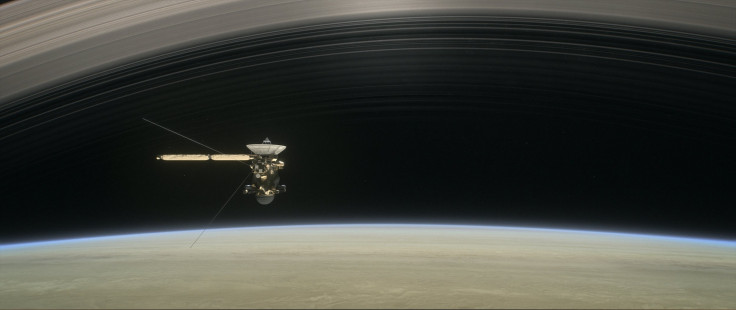Cassini Grand Finale Schedule: Spacecraft To Burn Up In Saturn Atmosphere

The Cassini spacecraft that launched nearly 20 years ago is in its final days of exploring Saturn. In April, NASA announced that the dependable craft will burn up in Saturn’s atmosphere on Sept. 15 in a “Grand Finale.”
After years of data returns and research the little craft is making it’s final dives through Saturn’s rings close to the surface of the gaseous planet. The craft is running out of fuel, so instead of waiting for the day the day the hypothetical gas light comes on NASA will plunge Cassini into Saturn’s atmosphere one last time for the craft to burn up. The reason for this being that if the craft runs out of fuel and collides with one of Saturn’s moons, it could contaminate or deplete the potential for life that they hold.
On April 22, the craft was boosted to put it on the path to the finale. And a few weeks ago the craft made the first of its final five flybys. The final week of the mission will include more final moves to provide NASA with data while preparing for the end.
Cassini is scheduled to make its final of 22 passes between Saturn and its rings on Sept. 9, just about a week before it makes the final plunge. During this last flyby the craft will come within 1,044 miles of the top of the clouds on Saturn. Two days later it will conduct a flyby of the moon Titan which will help slow the craft a bit.
The day before the craft burns up in the atmosphere it will send back its final photos of the planet system including the moons Titan and Enceladus, the rings and the pole. Around 2:45 p.m. PDT it is scheduled to turn its antenna towards Earth to establish a connection that will be utilized for the rest of the mission.
Less than 12 hours later, at 1:37 a.m. PDT on Sept. 15, the craft will start the final plunge into the atmosphere. At that time it will begin a roll into position that will be best for taking samples of the atmosphere and transmitting data back to Earth. At approximately 4:53 a.m. PDT the craft will enter the atmosphere of Saturn and the thrusters on the craft will fire at 10 percent capacity to keep Cassini on track and to keep the antenna pointed towards Earth.
Just a minute later the thrusters will increase to 100 percent capacity and the atmosphere will overwhelm the thrusters causing the craft to lose control of its orientation and the antenna to possible no longer point to Earth. When the antenna moves, communication from Cassini will stop forever effectively ending the mission. Cassini’s final moments will consist of it burning up in the atmosphere much like a meteor would.
© Copyright IBTimes 2024. All rights reserved.





















